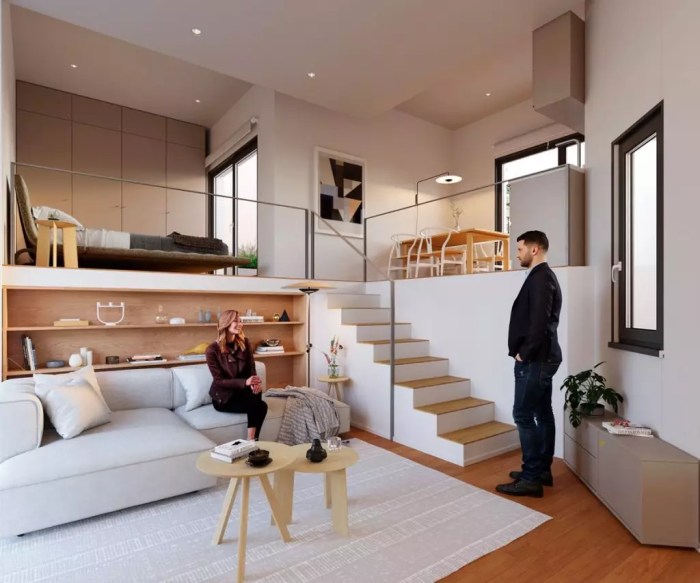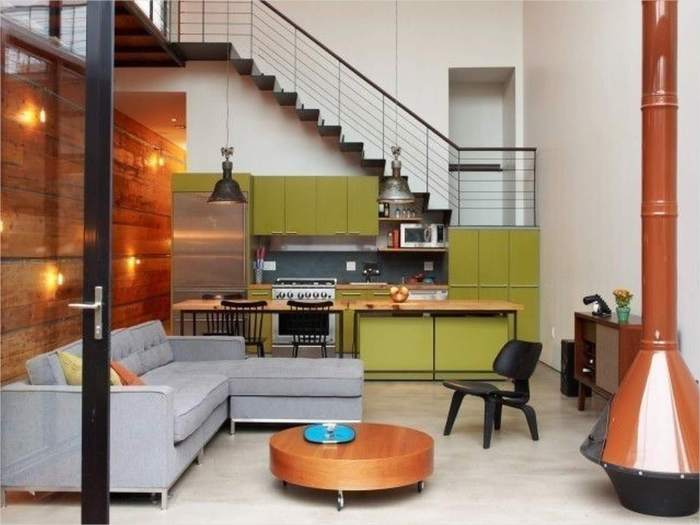Defining “Small Modern House Interior Design”

Small modern house interior design encompasses a specific aesthetic and functional approach to decorating smaller living spaces. It prioritizes clean lines, minimalist aesthetics, and a focus on maximizing space and light, all while embracing the core tenets of modern design. This style balances functionality with a visually appealing and sophisticated atmosphere, even within the constraints of limited square footage.Small modern house interiors prioritize functionality and efficiency, making the most of every square foot.
This is achieved through thoughtful spatial planning, clever storage solutions, and a curated selection of furniture and décor. The resulting environment is typically characterized by a sense of openness and airy spaciousness, despite its compact size.
Small modern house interior design often prioritizes maximizing space and light. This minimalist approach can be particularly effective in a multi-level home, and the principles translate well to larger projects. For instance, the spatial considerations found in designing a modern duplex house design often inform how to best utilize vertical space in smaller homes, leading to clever and efficient layouts.
Ultimately, both styles emphasize clean lines and functional aesthetics.
Square Footage Considerations for Small Modern Homes
Generally, a “small” modern house is considered to be under 1,000 square feet. However, this can vary depending on the location and local housing market. In densely populated urban areas, homes significantly smaller than this might still be classified as “small,” while in more suburban or rural settings, 1,000 square feet might be considered average or even slightly above average.
The key is the perception of space and how effectively the design maximizes functionality within the given area. For example, a well-designed 800 square foot home can feel significantly more spacious than a poorly designed 1,200 square foot home.
Defining Elements of Modern Design in Small Spaces
Modern design principles, when applied to small homes, emphasize simplicity, functionality, and clean lines. Neutral color palettes, natural materials (like wood and stone), and a lack of clutter are hallmarks of this style. Built-in storage, multi-functional furniture, and strategically placed mirrors are frequently used to maximize space and create an illusion of greater volume. Large windows are also a common feature, maximizing natural light and creating a connection with the outdoors.
A modern color palette might include shades of gray, white, beige, or black, accented with pops of bolder color used sparingly.
Comparison with Minimalist and Scandinavian Styles
While sharing similarities with minimalist and Scandinavian styles, small modern house interiors possess distinct characteristics. Minimalism focuses on extreme reduction, often to the point of sparseness. Small modern design, while embracing minimalism’s principles of simplicity, allows for a more curated and personalized approach. Scandinavian design, on the other hand, emphasizes natural light, functionality, and a sense of warmth, often incorporating more textiles and natural materials than a strictly modern aesthetic might.
Small modern design can incorporate elements from both styles, but it maintains a distinct focus on clean lines and a sophisticated, less overtly rustic or stark feel. For example, a small modern home might use the light, airy feel of Scandinavian design with the clean lines and minimal clutter of minimalism, but with a slightly more eclectic selection of furniture and art pieces than a purely minimalist design.
Space Optimization Techniques

Optimizing space in a small modern house requires a strategic approach to furniture placement, storage solutions, and the clever use of light and visual elements. By carefully considering these aspects, even the smallest homes can feel spacious and functional. This section will explore several key techniques to achieve this.
Living Room Layout for Maximum Functionality
A well-designed layout is crucial for maximizing the functionality and flow of a small modern living room. The following table illustrates a sample layout utilizing a three-column responsive design, adaptable to various room sizes and orientations. Consider using modular furniture that can be easily rearranged to suit your needs.
| Column 1 | Column 2 | Column 3 |
|---|---|---|
| Sofa (against a wall, ideally with built-in storage) | Coffee Table (small, possibly nesting tables) | TV Unit/Media Console (wall-mounted or slimline) |
| Floor Lamp (for ambient lighting) | Small side table (for drinks and remotes) | Plants (to add life and soften the space) |
| Storage Ottoman (for blankets and extra seating) | Rug (to define the seating area) | Artwork or Mirror (to visually expand the space) |
Clever Storage Solutions for Small Modern Houses
Effective storage is paramount in small spaces. The following examples highlight practical solutions that blend seamlessly with modern aesthetics.
Several storage solutions can significantly improve space utilization in a small modern home:
- Built-in shelving: Custom-built shelving units maximize wall space, offering ample storage for books, décor, and other items. These can be designed to fit specific niches and alcoves, eliminating wasted space. They provide a clean, integrated look.
- Multi-functional furniture: Ottomans with storage, coffee tables with drawers, and beds with built-in storage are excellent choices. These pieces serve multiple purposes, conserving valuable floor space while offering concealed storage.
- Vertical storage: Utilize vertical space with tall bookcases or storage towers. This strategy keeps items off the floor, creating a sense of openness and preventing clutter.
- Under-stair storage: The space under the stairs can be transformed into a valuable storage area using custom-built drawers or shelves. This often-overlooked space can be used for anything from shoes to seasonal items.
Using Mirrors to Create the Illusion of More Space
Mirrors strategically placed can dramatically enhance the perceived size of a room. By reflecting light and creating a sense of depth, mirrors visually expand the space, making it feel more airy and open. Consider a large mirror placed opposite a window to reflect natural light, or a series of smaller mirrors arranged on a wall to create a more dynamic effect.
The reflection adds a layer of visual interest and depth, counteracting the feeling of confinement often associated with small rooms.
Using Light to Create the Illusion of More Space
Adequate lighting is crucial for making a small space feel larger. Natural light should be maximized by using sheer curtains or blinds to allow ample sunlight to penetrate the room. In addition to natural light, a layered lighting scheme incorporating ambient, task, and accent lighting can significantly impact the perceived size of a room. Ambient lighting, such as recessed lighting or strategically placed floor lamps, creates a soft, overall illumination.
Task lighting, like desk lamps or reading lights, provides focused light for specific activities, and accent lighting, such as spotlights highlighting artwork or architectural features, adds visual interest and depth. The combination of these lighting elements creates a brighter, more spacious atmosphere.
Incorporating Built-in Furniture to Maximize Space Efficiency
Built-in furniture offers a seamless integration of storage and seating, maximizing space efficiency. Consider built-in seating with storage underneath, built-in bookshelves that extend to the ceiling, or a built-in media console that neatly houses electronics and accessories. These elements not only provide ample storage but also create a cohesive and streamlined aesthetic, avoiding the clutter of freestanding furniture. The custom design allows for optimization of space and creates a tailored look specific to the room’s dimensions and needs.
Illustrative Examples

The following examples showcase how texture, color, light, space-saving furniture, and clever storage solutions can transform small modern spaces into stylish and functional homes. These designs prioritize maximizing space and creating a sense of calm and sophistication.
Small Modern Living Room Design
This small modern living room (approximately 12ft x 14ft) features a neutral color palette with warm, earthy tones. The walls are painted a soft, warm grey, providing a backdrop for the textured elements. A large, plush, oatmeal-colored wool rug anchors the space, adding both warmth and visual interest. The sofa, a sleek, low-profile design in a light grey linen fabric, is positioned to maximize seating while leaving ample floor space.
A textured throw blanket in a deep teal adds a pop of color and a cozy touch. Natural light floods the room through large windows, complemented by strategically placed recessed lighting and a minimalist floor lamp with a linen shade. A coffee table made of light oak wood with a subtle grain adds a touch of natural warmth, contrasting beautifully with the grey and teal accents.
The overall effect is a space that feels both spacious and inviting, balancing modern minimalism with cozy textures.
Small Modern Bedroom Design
This small modern bedroom (approximately 10ft x 12ft) demonstrates efficient space utilization. A built-in wardrobe (4ft wide x 6ft high x 1ft deep) runs along one wall, maximizing storage without compromising floor space. The wardrobe doors are made of sleek, white lacquered wood, reflecting light and creating a sense of spaciousness. A platform bed (6ft x 4ft) with built-in drawers (2ft deep) provides additional storage and eliminates the need for a bulky bed frame.
The walls are painted a calming pale blue, and the bedding is predominantly white linen, with a textured throw in a muted grey. A small, round bedside table (2ft diameter) made of light oak wood sits beside the bed, holding a bedside lamp with a simple, minimalist design. The flooring is made of light oak engineered wood, creating a seamless transition between the different areas of the room.
The overall design prioritizes functionality and simplicity, creating a serene and relaxing space.
Small Modern Kitchen Design, Small modern house interior design
This small modern kitchen (approximately 8ft x 10ft) is designed for maximum efficiency and minimal visual clutter. Sleek, handleless cabinetry in matte white extends to the ceiling, providing ample storage space. The countertops are made of a durable, easy-to-clean quartz in a light grey color, creating a clean and contemporary look. Integrated appliances, such as a built-in refrigerator and oven, maintain a streamlined aesthetic and maximize space.
Open shelving above the countertop displays a curated selection of kitchenware, adding a touch of personality without overwhelming the space. The backsplash is a simple, white subway tile, creating a clean and classic look. The overall design is both functional and visually appealing, maximizing space and minimizing visual clutter to create a sophisticated and efficient cooking space.
Questions and Answers: Small Modern House Interior Design
What are some common mistakes to avoid when designing a small modern house interior?
Overcrowding the space with too much furniture, neglecting natural light, using dark or overly saturated colors, and ignoring proper storage solutions are common pitfalls.
How can I make a small modern bathroom feel more spacious?
Use light colors, install a large mirror, maximize vertical storage, and choose sleek, space-saving fixtures.
What are some affordable ways to update a small modern kitchen?
Replacing cabinet hardware, painting the walls a fresh color, adding new lighting fixtures, and incorporating stylish yet functional storage solutions can significantly improve the kitchen’s look and feel without breaking the bank.




